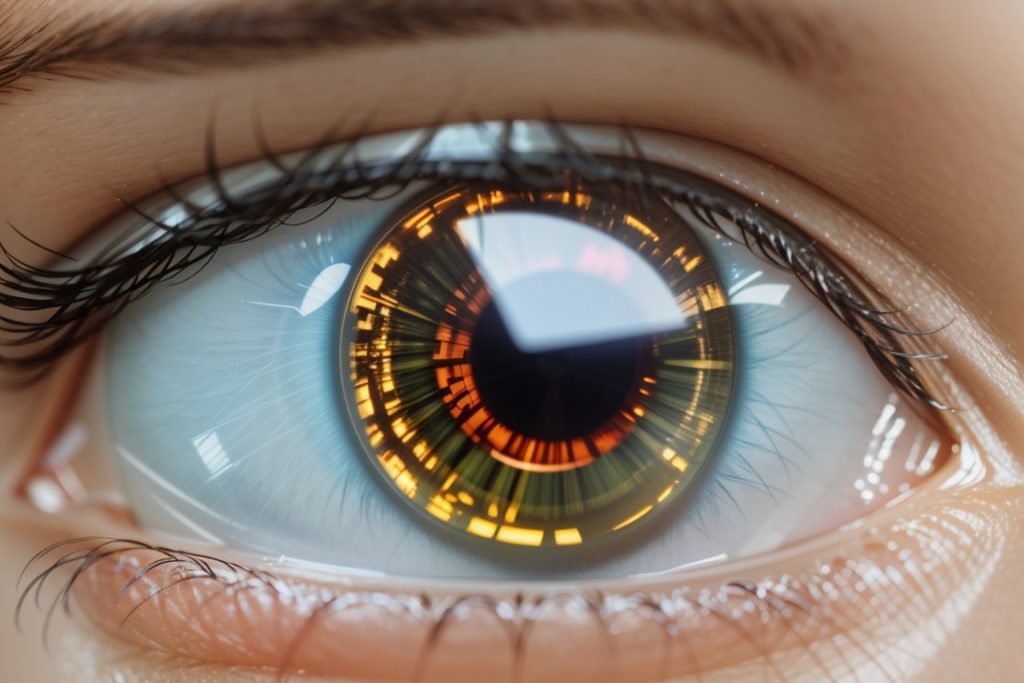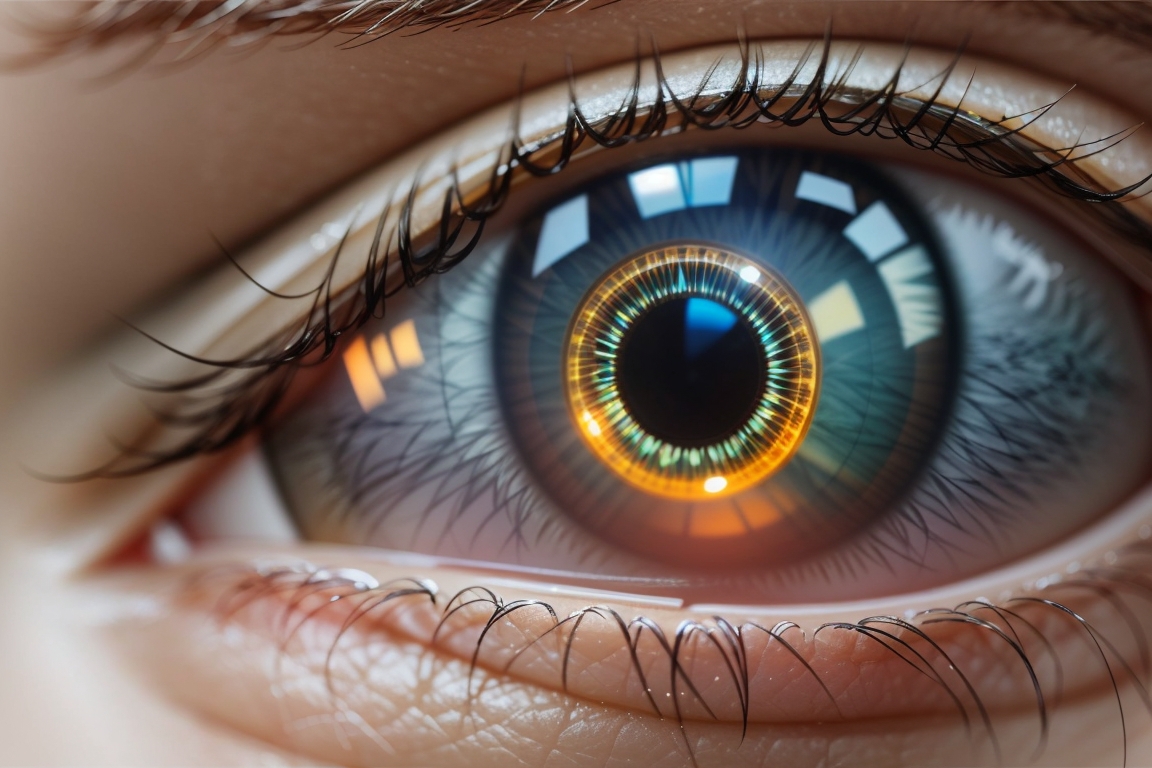Smart Contact Lenses and Augmented Reality:
Smart contact lenses and augmented reality are transforming the landscape of technology as we know it. As a powerful duo, these advancements are shaping the future by providing unparalleled ways to enhance our visual, audio, and haptic experiences. Augmented reality (AR) enriches our real-world environment with digital overlays, while smart contact lenses enable users to interface with AR seamlessly and discreetly.
Early strides in the development of smart contact lenses, such as Mojo Vision’s lens, foreshadow the potential for these lenses to replace smartphones, smartwatches, and even virtual reality headsets. As research progresses, companies like Bausch + Lomb collaborate with innovators to bring flexible electronic circuits directly into the contact lenses themselves, paving the way for greater consumer accessibility.
The true potential for these disruptive technologies lies in the myriad applications that will become possible once AR contact lenses are widely accessible. Be it in the realms of medicine, communication, or entertainment, smart contact lenses hold the key to unlocking new dimensions of sensory experience for users around the globe.
What are Smart Contact Lenses?
Smart contact lenses are innovative devices that go beyond the traditional use of correcting vision and have integrated electronic components such as microdisplays, wireless radios, image sensors, and motion sensors within the lens. These lenses can provide various functions like augmented reality, health monitoring, or even potentially replacing other devices like smartphones and smartwatches.
Applications of Smart Contact Lenses
- Augmented reality: Smart lenses, such as those developed by Mojo Vision, offer the potential to create immersive augmented reality experiences directly projected on the user’s field of vision. This technology could revolutionize industries like entertainment, navigation, and medical training.
- Health monitoring: Some smart contact lenses are being developed to measure bodily fluids, such as the glucose level in tears, which could help monitor conditions like diabetes and promote better health overall.
- Vision enhancement: Smart lenses have the potential to improve eyesight by using advanced features such as auto-focus lenses and task-specific sensors to ensure optimum vision correction for the user.
Potential Risks and Challenges
- Battery life: As smart lenses incorporate more electronics and features, power management becomes a challenge. Currently, the first generation of Mojo Lenses use wireless power, but future generations will require on-board batteries. Ensuring a safe and efficient power source for extended use is a crucial consideration.
- Privacy concerns: With the integration of cameras and sensors, smart lenses could pose a risk to individual privacy, as users may be able to record or gather information without consent. Clear guidelines and regulations must be put in place to address these concerns.
- Comfort and biocompatibility: As the lenses are in direct contact with the eye, ensuring they don’t cause discomfort or irritation is essential. Manufacturing materials and design must consider biocompatibility to make them safe for long-term use.
Augmented Reality: A Technology of the Future
Role of Augmented Reality in Various Sectors
Augmented reality (AR) is an innovative technology that combines real-world environments with digital or computer-generated information, enhancing the user’s perception and interaction with their surroundings. AR has already demonstrated its potential in various sectors, such as entertainment, education, healthcare, and manufacturing.
In the entertainment industry, AR applications have enhanced gaming experiences, providing users with immersive and interactive environments. Moreover, AR is revolutionizing the way people consume content, with applications like Snapchat and Instagram filters.
In the education sector, AR is proving to be a valuable tool for supporting learning and engagement. By integrating digital information with real-world environments, teachers can create interactive and dynamic lessons, better catering to different learning styles and needs.
Healthcare professionals are also benefiting from AR technology, particularly in medical training and surgery. AR-assisted surgical procedures can provide surgeons with critical information in real-time, potentially improving surgical outcomes and reducing the risks associated with complex operations.
The manufacturing industry is another sector where AR has demonstrated considerable potential. By overlaying digital information onto physical spaces, AR can help workers visualize complex designs and streamline workflows, ultimately improving efficiency and reducing errors.

Potential Hurdles for Augmented Reality
Despite the tremendous potential of AR, there are some challenges that must be addressed before the technology can achieve widespread adoption. One significant concern is the cost of AR hardware and software, which may be prohibitive for some industries and consumers. Furthermore, as AR relies on advanced and resource-intensive technologies, it could contribute to increased energy consumption.
Privacy and security are also important considerations, especially as AR applications collect and process vast amounts of data. Ensuring that users can maintain control over their personal information and that their privacy is respected will be crucial for the technology’s success.
Additionally, AR’s current reliance on wearable devices like headsets and glasses may limit its potential user base. While some companies are already pioneering augmented reality contact lenses, there’s still a long way before we see widespread adoption of this technology.
Lastly, the ethical implications of AR are equally important. As the technology becomes more immersive, users could potentially struggle to distinguish between their real-world experiences and those created by AR. Establishing ethical guidelines and fostering a responsible approach toward AR technology will be vital in ensuring that its potential benefits can be harnessed while minimizing its potential negative impacts.
Integration of Smart Contact Lenses and Augmented Reality
Benefits of Integration
The integration of smart contact lenses and augmented reality promises to revolutionize the way we interact with our environment. By combining the comforts of wearing contact lenses with the cutting-edge technology of AR, users can experience a seamless blend of digital information within their natural field of vision. The Mojo Vision’s smart contact lens is an example of this innovation, designed to replace smartphones, smartwatches, AR glasses, and even VR headsets.
One significant benefit of this integration is the unobtrusive design of smart contact lenses. Unlike bulky AR headsets, contact lenses are lightweight, discreet, and do not interfere with the user’s peripheral vision. This allows users to engage with digital content without removing them from their actual surroundings, enhancing their ability to multitask and respond to real-world stimuli.
Additionally, smart contact lenses enable users to access various types of information instantaneously. From real-time navigation and translations to contextual information about people and places, users can access critical data discreetly, without disrupting their interactions.
Concerns with Integration
Despite the potential benefits, integrating smart contact lenses with augmented reality technology also raises concerns. Privacy issues stand out as one of the most pressing ethical dilemmas. The capability to capture, record, and share images and data from a contact lens could potentially infringe on people’s privacy rights, particularly in public spaces. Ensuring transparent communication regarding how and when data is being collected and used will be crucial in addressing these concerns.
Another concern lies in the potential health risks that prolonged use of smart contact lenses might impose. As contact lenses are designed to be placed directly on the eye, there may be risks associated with long-term exposure to electronic components and wireless signals, including eye strain and irritation. Ensuring proper safety guidelines and regular updates to users on potential health risks is of paramount importance.
In conclusion, as smart contact lenses and augmented reality technology continue to develop, both benefits and concerns must be carefully considered. By addressing these issues and working collaboratively with users, developers, and regulatory bodies, we can ensure responsible integration and unlock the full potential of this promising technology.
Future Prospects
Advancements in Technology
The development of smart contact lenses has seen significant progress recently. With prototypes featuring 14K-pixel-per-inch resolution microdisplays, image sensors, motion sensors, and wireless radios, these wearable devices are on the brink of revolutionizing the augmented reality (AR) industry.
Current Research
Researchers are continuously working to enhance the capabilities of smart contact lenses. One promising advancement is in the field of health monitoring, which includes glucose sensing. Additionally, a research team at Ulsan National Institute of Science and Technology has introduced core technology for smart contact lenses, aiming to implement various functions for managing digital devices and monitoring health.
Integration with AR Technology
Smart contact lenses, when combined with AR, have the potential to revolutionize digital experiences. Instead of using cumbersome headsets, users will be able to visualize data, navigate directions, and interact with virtual environments through their contact lenses. AR integration is expected to propel the technology into mainstream adoption, transforming industries like healthcare, gaming, and social media.
Legislation and Policy Outlook
As smart contact lenses and AR technologies advance, legislation and regulatory policies will need to keep pace. Governments worldwide will need to address topics such as data privacy, security, and ethical concerns raised by these new technologies.
Data Protection and Privacy
Wearable technologies like smart contact lenses collect vast amounts of personal data, including health information. Legislators must ensure that data protection laws are in place to protect user privacy and prevent unauthorized access and misuse of sensitive data.
Ethical Considerations
As AR becomes more integrated into daily life, ethical questions around the use of augmented reality will arise. It is the responsibility of policymakers to establish guidelines and regulations that address concerns like virtual boundaries, harassment in the digital space, and psychological effects that AR may have on users.
In summary, the future prospects of smart contact lenses and AR technologies are promising, with rapid advancements in technology and the potential to revolutionize multiple industries. However, appropriate legislation and policies must be implemented to address concerns related to data privacy, security, and ethics, ensuring a responsible and balanced growth of these groundbreaking technologies.
Conclusion
Smart contact lenses and augmented reality (AR) are on the horizon, promising to revolutionize how we interact with the world around us. These innovative technologies could eventually become an integral part of our daily lives, making cumbersome headsets obsolete ITPro.
AR contact lenses enhance our perception of reality by overlaying computer-generated information onto the real world, enabling a unique and interactive experience Lens.com. These lenses may provide a wide range of benefits, such as more streamlined access to information, enhanced communication, and improved experiences in entertainment and gaming.
In addition to their potential for AR, smart contact lenses may also offer the possibility of monitoring health parameters, such as glucose sensing, opening the door to reconsider the capabilities of contact lenses New Atlas.
Nevertheless, it is important to recognize that the technology is still in its early stages. Challenges, such as power management, device miniaturization, and user comfort, need to be addressed before these lenses become mainstream. As the technology progresses, researchers and companies are working diligently to make smart contact lenses feasible and accessible to consumers.
In conclusion, smart contact lenses and augmented reality technologies hold great promise for the future. As these innovative solutions continue to evolve, they may significantly impact our interaction with information and the world around us, paving the way for new possibilities in daily life, communication, entertainment, and healthcare.

